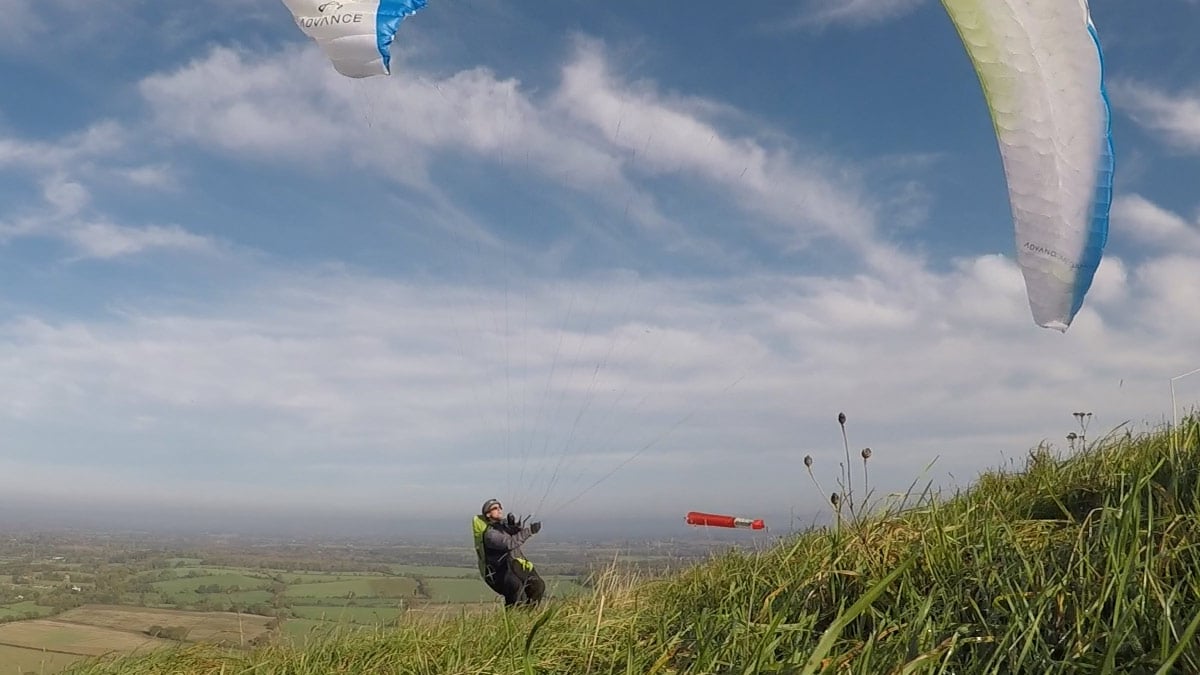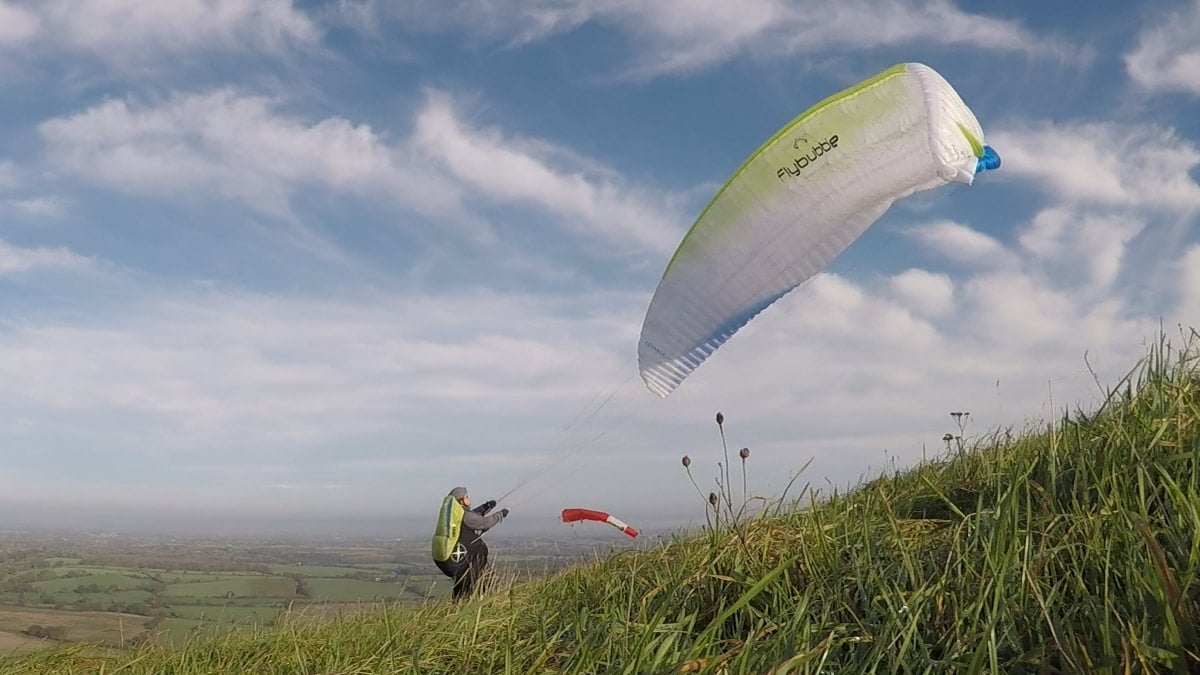
Launching in strong wind is difficult to learn, because if you get it wrong you’re quickly overpowered. Here’s a technique that reduces the force generated by the paraglider, allowing you to stay in control. Well, for a little while anyway …
We explained how to depower a paraglider by running hard at the wing during the launch. That technique works really well on wings that require a gentle pull on the A risers to avoid a stall point half way up (slow launchers). Examples of these would be some wings in the EN B class designed to ‘help the pilot by limiting overshooting energy’, old wings, out of trim wings, wet wings, and all two-liners. These wings require you to stay on the A’s during launch control to avoid the wing falling back into the ‘dead zone’ where they will stall, spin, and create havoc in the wind.
Many modern wings with reinforced leading edges and ‘sporty’ trim have a more positive nature – if released at 45 degrees they will rise again. In strong wind, this kind of wing can be launched without using the risers to pull it up, especially on a slope. A sudden step into wind is all that is required.
Because the risers are at level trim, the wing does not accelerate in the way that a wing with pulled A risers (accelerated) would do. The pilot’s hands are free to hold the back risers – one in each hand – which provides a lot of steering and depowering control.
Let’s see how it works
Prepare to launch
I open the wing using my body weight and the back risers, and I've got the back risers in the correct hands for flying, so my arms are crossed.
What this allows me to do is bring the wing up, it will automatically turn me the right way, this keeps control throughout, and in strong wind that's important.
Depower: on the way up
As the wing comes up, I run a little towards it to and try and ease the power off as it's coming up so I make it as smooth as possible. I depower (pulling the rear risers) a little as the wing reaches about 45 degrees, and again near the top, and then I can hold it there.
In the video I deliberately prevent the wing from flying, to demonstrate the depower effect. For this purpose it is obvious that the brakes generate a huge amount of lift that is not present with the rear riser control method. However, if you have a clean launch there’s absolutely no reason to try and keep the wing ‘controlled’ in this powerful lift on the launch site. Accidents are caused by pilots trying to ‘stop/control’ the wing to ‘check it/be sure’ before committing to flying. Make your flying decision before you start pulling up. The depower is useful for emergencies (to abort the launch) and for giving you more time to get a smooth continuous pullup. But once it’s up, turn through and fly!
When compared with the traditional A’s and brakes launch technique, the rear riser depower typically uses less space and gives less of a whip-kick that plucks you off the ground. However, expert pilots can almost completely remove that energy by running at the wing during the pullup.

Depower: on the way down
Rear risers are also better at bringing the wing down in strong winds, so having your hands already on these controls means you can drop the wing safely without the mess that brake-line-stalling can cause. Release the rear risers before the wing reaches the ground to achieve a soft touchdown.
If your wing has good behaviour near the stall point, you can topland using the back risers to butterfly (a kind of pumping motion that brings your wing very close to the stall point, see our stall point article). This produces a steeper descent than using the brakes, and gives you instant control on touchdown. It only works in strong wind, because your flying speed is higher.

A’s and C’s depower technique?
If you've got a wing that doesn't come up on its own, and it needs some A's, you might like to try the A's in one hand and the C's in the other hand. I don't like this technique because it can overpower you (particularly on a B rated wing), if you've got both the back risers in one hand, that's a lot of strength you need to control the pull from the glider, and it can easily overpower the pilot, especially if you are not muscular. Then the wing gets away from you, in a very critical position. It also is very limited in steering control on some gliders, because you can only go so far. Once the glider has yawed beyond a certain point you lose your steering control, and you’ll have to stall it down and restart. I'd much rather be on back risers, one in each hand, so you've got much more strength to control one side or the other, and because the risers are further apart, the steering actually works.
Play with your wing and see what suits it best. Some wings (usually Nova wings) respond well to A’s and C’s. If neither the A’s and C’s nor the rear riser control works for you, then the A’s and run-at-the-wing technique is recommended.

Staying in control
If you keep your weight low with one foot forwards, it gives you more resistance to being plucked, it gives you more time to depower the glider, rather than standing right up on your tippy-toes looking up, then you're going to get lifted. Go down, and look to the side, at the tips, and that way you get a lot more control, and a lot more time. Only transition to the brakes when you want to fly: if you want to stay on the ground, use the rear risers only. You can pull the rear risers in at any time and put the wing down softly on the ground.
Depower by sliding?
Some pilots recommend sliding towards the wing to get a steady launch. The problem with sliding in strong wind is that any uneven surface will grip your feet (and risk a broken ankle) giving a very jerky pull which is worse than running. It only really works when you're at somewhere flat covered in gravel, sand or snow that you can slide on.
Strong wind: begone!
For a safe launch in strong wind, combining the three elements is best: running back at the wing, rear riser control, and not messing around with it when it’s flying. Bring it up, let it fly!

